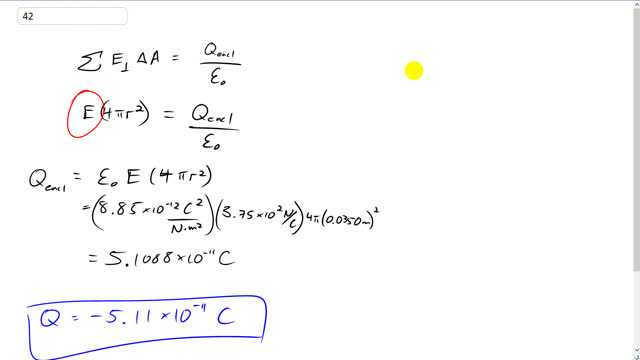
The field just outside a 3.50-cm-radius metal ball is and points toward the ball. What charge resides on the ball?

In order to watch this solution you need to have a subscription.
This is Giancoli Answers with Mr. Dychko. The total flux equals the enclosed charge divided by permittivity of free space and the total flux is gonna be electric field strength which is perpendicular to a sphere around this metal ball and so we can take the electric field strength and it's effectively constant since it's perpendicular to every point on this area and multiply by the area and the area of a sphere is four pi r squared. So we can solve for the enclosed charge by multiplying both sides by epsilon naught and we get Q enclosed is Epsilon naught times electric field strength times four Pi radius squared. So it's 8.85 times 10 to the minus 12 coulomb squared per newton meter squared times 3.75 times ten to the two Newtons per coulomb electric fields strength times four pi times 0.035 meters squared and the enclosed charge is negative because the field lines are pointing towards the charge and that's the picture you have for the electric field due to negative point charge so negative 5.11 times ten to the minus 11 coulombs is the enclosed charge.
Hello!
Sorry to bother you, but shouldn't the answer to the problem be Q = -5.11 x 10^-11 C, instead of to the 4th power? Just thought I would help you out!
Hi giancoli4747, that's no bother at all, but quite the opposite! Thank you for pointing out the typo in the quick answer. I've updated it to , as it shows in the video.
Best wishes with your studies,
Mr. Dychko
Why do we need area of a sphere?
The sphere is chosen as a convenient surface for applying Gauss's Law. It's convenient since the electric field is directed perpendicular to that surface, and Gauss's Law refers specifically to the perpendicular component of electric fields to a given surface. Choosing a box, on the other hand, would create issues with finding components of the electric field perpendicular to each box surface.